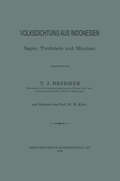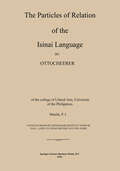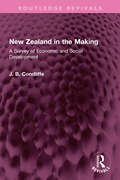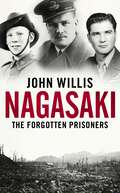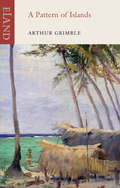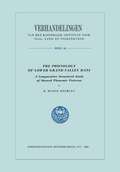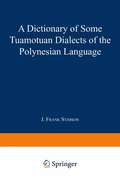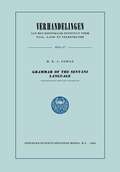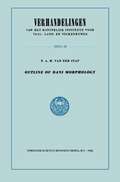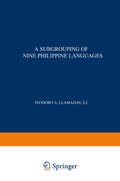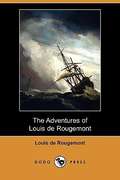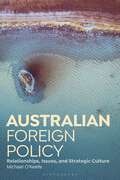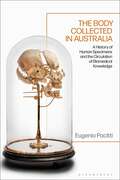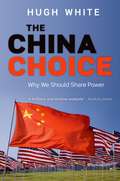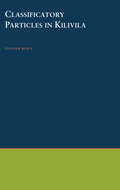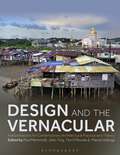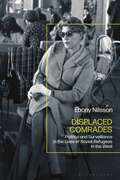- Table View
- List View
New Zealand in the Making: A Survey of Economic and Social Development (Routledge Revivals)
by J. B. CondliffeFirst published in 1930, New Zealand in the Making is an economic history of the democratic experiments in New Zealand. The geography, population, government ownership of public utilities, compulsory arbitration, pensions and all other factors have been covered in detail. The book will be of interest to anyone keen on learning about New Zealand as well as to students of economy, history, agriculture, and government.
New Zealand in the Making: A Survey of Economic and Social Development (Routledge Revivals)
by J. B. CondliffeFirst published in 1930, New Zealand in the Making is an economic history of the democratic experiments in New Zealand. The geography, population, government ownership of public utilities, compulsory arbitration, pensions and all other factors have been covered in detail. The book will be of interest to anyone keen on learning about New Zealand as well as to students of economy, history, agriculture, and government.
Nagasaki: The Forgotten Prisoners
by John WillisThis is one of the most remarkable untold stories of the Second World war. At 11.02 am on an August morning in 1945 America dropped the world's most powerful atomic bomb on the Japanese port city of Nagasaki. The most European city in Japan was flattened to the ground 'as if it had been swept aside by a broom'. More than 70,000 Japanese were killed. At the time, hundreds of Allied prisoners of war were working close to the bomb's detonation point, as forced labourers in the shipyards and foundries of Nagasaki.These men, from the Dales of Yorkshire and the dusty outback of Australia, from the fields of Holland and the remote towns of Texas, had already endured an extraordinary lottery of life and death that had changed their lives forever. They had lived through nearly four years of malnutrition, disease, and brutality. Now their prison home was the target of America's second atomic bomb.In one of the greatest survival stories of the Second World War, we trace their astonishing experiences back to bloody battles in the Malayan jungle, before the dramatic fall of Fortress Singapore, the mighty symbol of the British Empire. This abject capitulation was followed by surrender in Java and elsewhere in the East, condemning the captives to years of cruel imprisonment by the Japanese. Their lives grew evermore perilous when thousands of prisoners were shipped off to build the infamous Thai-Burma Railway, including the Bridge on the River Kwai. If that was not harsh enough, POWs were then transported to Japan in the overcrowded holds of what were called hell ships. These rusty buckets were regularly sunk by Allied submarines, and thousands of prisoners lived through unimaginable horror, adrift on the ocean for days. Some still had to endure the final supreme test, the world's second atomic bomb.The prisoners in Nagasaki were eyewitnesses to one of the most significant events in modern history but writing notes or diaries in a Japanese prison camp was dangerous. To avoid detection, one Allied prisoner buried his notes in the grave of a fellow POW to be reclaimed after the war, another wrote his diary in Irish. Now, using unpublished and rarely seen notes, interviews, and memoirs, this unique book weaves together a powerful chorus of voices to paint a vivid picture of defeat, endurance, and survival against astonishing odds.
A Pattern of Islands (Ulverscroft Large Print Ser.)
by Arthur GrimbleArthur Grimble was sent to the Gilbert and Ellice islands as a colonial administrator in the twilight of the Edwardian era. He lived there for the next twenty-five years and developed a rare passion for the language, life and landscape of the place. Fortunately his island neighbours, a fascinating cast of fishermen, sorcerers, poets and fighters, began to trust this charming, happy and energetic young man, and shared with him their treasury of stories from the days when warfare was endemic and magic an essential part of everyday life. A Pattern of Islands is a rich and complex cultural history of the dances and legends, rituals, spells and way of life of the islands. It is also a riproaring adventure story. Grimble learns to spear hungry sharks, to negotiate fearsome reefs and, on one terrifying day, is used as human bait to catch a giant squid.
The Phonology of Lower Grand Valley Dani: A Comparative Structural Study of Skewed Phonemic Patterns (Verhandelingen van het Koninklijk Instituut voor Taal-, Land- en Volkenkunde)
by H. Myron BromleyA Critical Survey of Studies on the Languages of Java and Madura: Bibliographical Series 7 (Koninklijk Instituut voor Taal-, Land- en Volkenkunde #3)
by E.M. UhlenbeckAt the completion of this critical bibliography which forms another step in the direction of the realization of the bibliographical project inaugurated in 1955 by Dr. Voorhoeve's survey of the languages of Sumatra, I acknowledge with gratitude the valuable assistance received from various people. I am indebted to my colleagues Prof. Dr. G. W. J. Drewes, Dr. J. Noorduyn, Dr. Th. Pigeaud, Prof. Dr. A. Teeuw and Dr. P. Voorhoeve, who read all or part of the manuscript and who generously put their extensive knowledge of the Java languages at my disposal. Heartfelt thanks are due to Mr. B. J. Hoff and Mr. A. G. Sciarone, both members of my staff, who verified many of the biblio graphical details. I am grateful to the library of the University of Leiden and to the library of the Institute in The Hague because of their readiness in giving me all the facilities I needed for the preparation of this book. Most useful was the cordial assistance received from my colleague Prof. Dr. P. E. de Josselin de Jong, who spent much time correcting the many imperfections of my English text, which greatly promoted the readability of the narrative sections of this survey.
A Dictionary of Some Tuamotuan Dialects of the Polynesian Language
by J.F. Stimson Donald Stanley MarshallGrammar of the Sentani Language (Verhandelingen van het Koninklijk Instituut voor Taal-, Land- en Volkenkunde #47)
by Hendrik Karel CowanOutline of Dani Morphology (Verhandelingen van het Koninklijk Instituut voor Taal-, Land- en Volkenkunde #48)
by P.A.M. van van der StapA Subgrouping of Nine Philippine Languages
by NA LlamzonBY J. C. ANCEAUX Since the appearance of Brugmann's famous article on the relation ships of the Indo-European languages in 1884, the subject of sub grouping of languages as a methodological problem has been raised only occasionally. To this apparent lack of interest in a major point in comparative linguistics several causes can be assigned. One of them is that a consensus has been reached about the main outlines of the family-tree for the language-family which has received more attention than any other: the Indo-European. Another explanation is that for most of the branches of this family historical materials are available which have proved very valuable for the reconstruction of the inter mediate stages between the proto-Ianguage ande the modem languages. For a few branches only has the problem of subgrouping been a matter for discussion (e.g. Germanic). Special attention, however, could be expected from those who started to apply the comparative methods to other language-families. This attention did come forward, though not immediately, because linguists first had to deal with the problems of proving the existence of the family in question and deciding which languages belonged to it. For the Austronesian languages serious attemps to arrive at a lin guistic classification started relatively late. Certain cases of closer relationships were obvious enough to be recognized very early ( e.g.
The Adventures of Louis de Rougemont
by Louis De RougemontLouis de Rougemont (1847-1921) was a would-be explorer who claimed to have had adventures in Australasia. "de Rougemont" was born Henri Louis Grin in 1847 in Suchy, Switzerland. <P> <P> In 1898 he began to write about his invented adventures in the British periodical The Wide World Magazine under the name Louis de Rougemont. He described his alleged exploits in search of pearls and gold in New Guinea and claimed to have spent thirty years living with Indigenous Australians in the Australian outback. He claimed that the tribe with whom he had lived had worshipped him as a god. He also claimed to have encountered the Gibson expedition of 1874. Various readers expressed disbelief in his tales from the start, for example, claiming that no one can actually ride a turtle. He had also claimed to have seen flying wombats. The fact that he could not place his travels on the map aroused suspicion. Readers' arguments in the pages of London newspaper, the Daily Chronicle, continued for months.
Australian Foreign Policy: Relationships, Issues, and Strategic Culture
by Michael O'KeefeHow does Australia's unique geographical, cultural and historical position influence its approach to foreign policy? What key challenges does Australia face on the world stage, and how can it overcome them? Reflecting the messy reality of foreign policy decision-making, this book helps you to understand the changes and continuities in Australia's approach. For example, does the US withdrawal from Vietnam in 1973 and collapse of South Vietnam continue to cast a shadow over Australian foreign policy, or is it relevant only in understanding the dynamics of the cold war? Using an Australian Strategic Culture framework, O'Keefe sheds light on the characteristics that make Australia behave in a way different to any other country and equips you with analytic skills to understand the main debates, such as:- In what sense could Australia be seen as a 'good' international citizen? - Have national interests trumped global responsibilities? - How does the intersection between civil society and public opinion interact with foreign policy making?This book is essential reading if you are a student of Australian foreign policy, as well as of broader Australian domestic politics and international relations.
Australian Settler Colonialism and the Cummeragunja Aboriginal Station: Redrawing Boundaries (First Nations and the Colonial Encounter)
by Fiona DavisIn 1938, the anthropologist Norman Tindale gave a classroom of young Aboriginal children a set of crayons and asked them to draw. The children, residents of the government-run Aboriginal station Cummeragunja, mostly drew pictures of aspects of white civilization boats, houses and flowers. What now to make of their artwork? Were the children encouraged or pressured to draw non-Aboriginal scenes, or did they draw freely, appropriating the white culture they now lived within? Did their Aboriginality change the meaning of their art, as they sketched out this ubiquitous colonial imagery? Australian Settler Colonialism and the Cummeragunja Aboriginal Station traces Cummeragunja's history from its establishment in the 1880s to its mass walk-off in 1939 and finally, to the 1960s, when its residents regained greater control over the land. Taking in oral history traditions, the author reveals the competing interests of settler governments, scientific and religious organizations, and nearby settler communities. The nature of these interests has broad and important implications for understanding settler colonial history. This history shows white people set boundaries on Aboriginal behaviour and movement, through direct legislation and the provision of opportunities and acceptance. But Aboriginal people had agency within and, at times, beyond these limits. Aboriginal people appropriated aspects of white culture including the houses, the flowers and the boats that their children drew for Tindale - reshaping them into new tools for Aboriginal society, tools with which to build lives and futures in a changed environment.
The Body Collected in Australia: A History of Human Specimens and the Circulation of Biomedical Knowledge
by Eugenia PacittiOffering insight into nineteenth- and early twentieth-century medical school dissecting rooms and anatomy museums, this book explores how collected human remains have shaped Western biomedical knowledge and attitudes towards the body. To explore the role Australia played in the narrative of Western medical development, Pacitti focuses on how and why Australian anatomists and medical students obtained human body parts. As medical knowledge circulated between Australia and Britain, the colony's physicians conformed to established specimen collecting practices and diverged from them to form a distinct medical identity. Interrogating how these literal and figurative bones of contention have left an indelible mark on the nation's medical profession, collecting institutions, and communities, Pacitti sheds new light on our understanding of Western medical networks and reveals the opportunities and challenges historic specimen collections pose in the present day.The Body Collected in Australia is a cultural history of collectors and collections that deepens our understanding of the ways the living have used the dead to comprehend the intricacies of the human body in illness and good health.
Classificatory Particles In Kilivila
by Gunter SenftCommon among the world's languages is the phenomenon of classification, a partly or fully grammatical division of the noun lexicon into distinct classes that ultimately derives from the human need to classify and filter data on various levels while communicating. In this book, Senft describes and develops a grammar of classificatory particles in Kilivila, an Austronesian language of the Trobriand Islanders in Papua New Guinea. Drawing largely on his anthropological and linguistic fieldwork in the islands, and emphasizing the use of classifiers in a social context, Senft provides quantitative data and a statistical profile of the status and use of these particles, and the classifier system that employs them.
The Cruise of the Snark
by Jack LondonThe Cruise of the Snark (1911) is a memoir of Jack and Charmian London''s 1907-1909 voyage across the Pacific. His descriptions of surf-riding, which he dubbed a royal sport, helped introduce it to and popularize it with the mainland. London writes: Through the white crest of a breaker suddenly appears a dark figure, erect, a man-fish or a sea-god, on the very forward face of the crest where the top falls over and down, driving in toward shore, buried to his loins in smoking spray, caught up by the sea and flung landward, bodily, a quarter of a mile. It is a Kanaka on a surf-board. And I know that when I have finished these lines I shall be out in that riot of colour and pounding surf, trying to bit those breakers even as he, and failing as he never failed, but living life as the best of us may live it. . from Wikipedia, The Free Encyclopedia. Intuitive navigation. . Text annotation and mark-up. .
Design and the Vernacular: Interpretations for Contemporary Architectural Practice and Theory
Design and the Vernacular explores the intersection between vernacular architecture, local cultures, and modernity and globalization, focussing on the vast and diverse global region of Australasia and Oceania. The relevance and role of vernacular architecture in contemporary urban planning and architectural design are examined in the context of rapid political, economic, technological, social and environmental changes, including globalization, exchanges of people, finance, material culture, and digital technologies. Sixteen chapters by architects designers and theorists, including Indigenous writers, explore key questions about the agency of vernacular architecture in shaping contemporary building and design practice. These questions include: How have Indigenous and First Nations building traditions shaped modern building practices? What can the study of vernacular architecture contribute to debates about sustainable development? And how has vernacular architecture been used to argue for postcolonial modernisation and nation-building and what has been the effect on heritage and conservation? Such questions provide valuable case studies and lessons for architecture in other global regions -- and challenge assumptions about vernacular architecture being anachronistic and static, instead demonstrating how it can shape contemporary architecture, nation building and cultural identities.
Displaced Comrades: Politics and Surveillance in the Lives of Soviet Refugees in the West
by Ebony NilssonThis book explores the lives of left-wing Soviet refugees who fled the Cold War to settle in Australia, and uncovers how they adjusted to life under surveillance in the West. As Cold War tensions built in the postwar years, many of these refugees happily resettled in the West as model refugees, proof of capitalist countries' superiority. But for a few, this was not the case. Displaced Comrades provides an account of these Cold War misfits, those refugees who fled East for West, but remained left-wing or pro-Soviet. Drawing on interviews, government records and surveillance dossiers from multiple continents this book explores how these refugees' ideas took root in new ways. As these radical ideas drew suspicion from western intelligence these everyday lives were put under surveillance, shadowed by the persistent threat of espionage. With unprecented access to intelligence records, Nilsson focuses on how a number of these left-wing refugees adjusted to life in Australia, opening up a previously invisible segment of postwar migration history, and offering a new exploration of life as a Soviet 'enemy alien' in the West.
